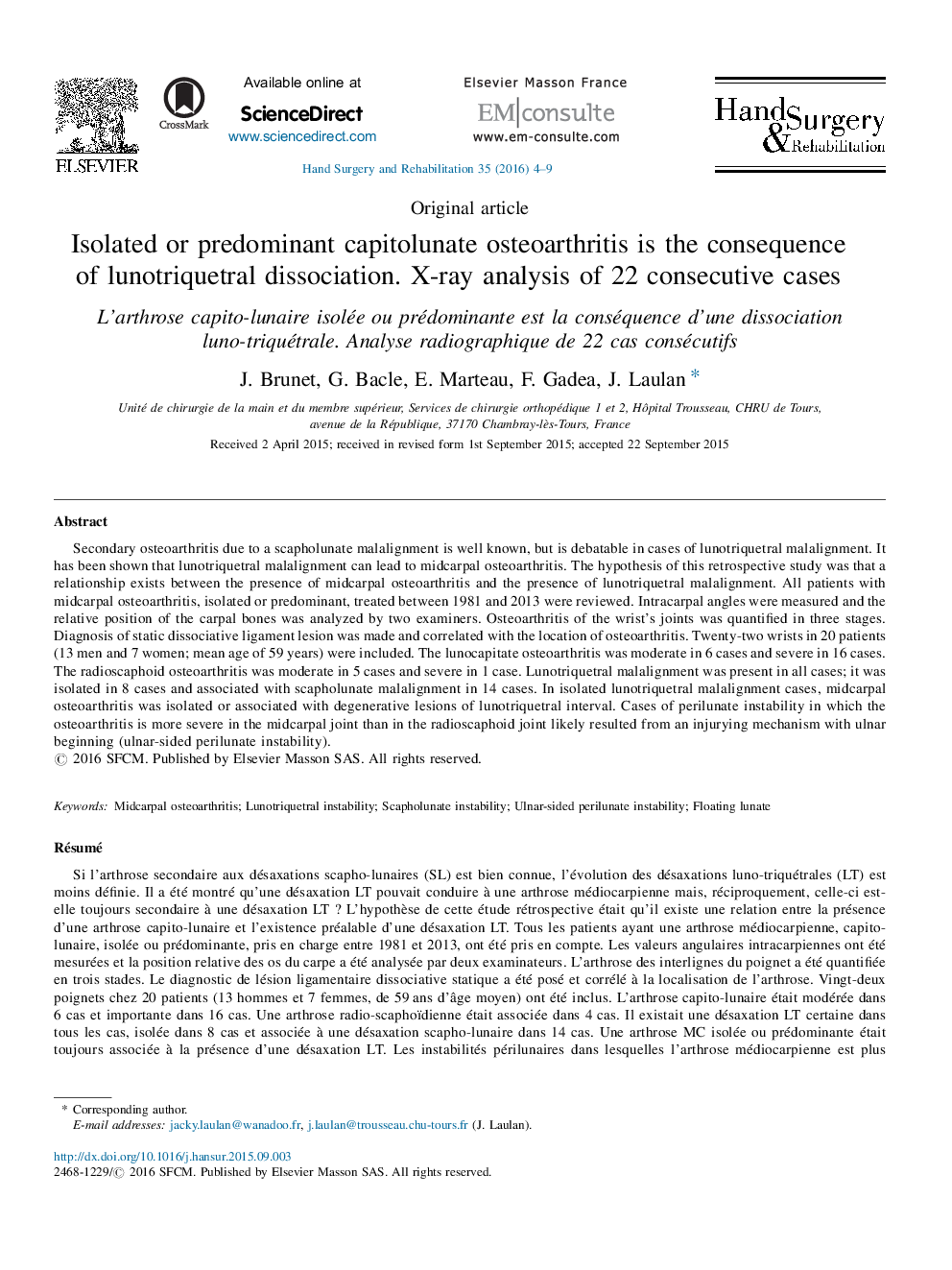| کد مقاله | کد نشریه | سال انتشار | مقاله انگلیسی | نسخه تمام متن |
|---|---|---|---|---|
| 4059766 | 1265868 | 2016 | 6 صفحه PDF | دانلود رایگان |

Secondary osteoarthritis due to a scapholunate malalignment is well known, but is debatable in cases of lunotriquetral malalignment. It has been shown that lunotriquetral malalignment can lead to midcarpal osteoarthritis. The hypothesis of this retrospective study was that a relationship exists between the presence of midcarpal osteoarthritis and the presence of lunotriquetral malalignment. All patients with midcarpal osteoarthritis, isolated or predominant, treated between 1981 and 2013 were reviewed. Intracarpal angles were measured and the relative position of the carpal bones was analyzed by two examiners. Osteoarthritis of the wrist's joints was quantified in three stages. Diagnosis of static dissociative ligament lesion was made and correlated with the location of osteoarthritis. Twenty-two wrists in 20 patients (13 men and 7 women; mean age of 59 years) were included. The lunocapitate osteoarthritis was moderate in 6 cases and severe in 16 cases. The radioscaphoid osteoarthritis was moderate in 5 cases and severe in 1 case. Lunotriquetral malalignment was present in all cases; it was isolated in 8 cases and associated with scapholunate malalignment in 14 cases. In isolated lunotriquetral malalignment cases, midcarpal osteoarthritis was isolated or associated with degenerative lesions of lunotriquetral interval. Cases of perilunate instability in which the osteoarthritis is more severe in the midcarpal joint than in the radioscaphoid joint likely resulted from an injurying mechanism with ulnar beginning (ulnar-sided perilunate instability).
RésuméSi l’arthrose secondaire aux désaxations scapho-lunaires (SL) est bien connue, l’évolution des désaxations luno-triquétrales (LT) est moins définie. Il a été montré qu’une désaxation LT pouvait conduire à une arthrose médiocarpienne mais, réciproquement, celle-ci est-elle toujours secondaire à une désaxation LT ? L’hypothèse de cette étude rétrospective était qu’il existe une relation entre la présence d’une arthrose capito-lunaire et l’existence préalable d’une désaxation LT. Tous les patients ayant une arthrose médiocarpienne, capito-lunaire, isolée ou prédominante, pris en charge entre 1981 et 2013, ont été pris en compte. Les valeurs angulaires intracarpiennes ont été mesurées et la position relative des os du carpe a été analysée par deux examinateurs. L’arthrose des interlignes du poignet a été quantifiée en trois stades. Le diagnostic de lésion ligamentaire dissociative statique a été posé et corrélé à la localisation de l’arthrose. Vingt-deux poignets chez 20 patients (13 hommes et 7 femmes, de 59 ans d’âge moyen) ont été inclus. L’arthrose capito-lunaire était modérée dans 6 cas et importante dans 16 cas. Une arthrose radio-scaphoïdienne était associée dans 4 cas. Il existait une désaxation LT certaine dans tous les cas, isolée dans 8 cas et associée à une désaxation scapho-lunaire dans 14 cas. Une arthrose MC isolée ou prédominante était toujours associée à la présence d’une désaxation LT. Les instabilités périlunaires dans lesquelles l’arthrose médiocarpienne est plus évoluée que celle de la radio-scaphoïdienne pourraient résulter d’un mécanisme lésionnel à début ulnaire. Les désaxations LT doivent être diagnostiquées et traitées au même titre que les SL.
Journal: Hand Surgery and Rehabilitation - Volume 35, Issue 1, February 2016, Pages 4–9